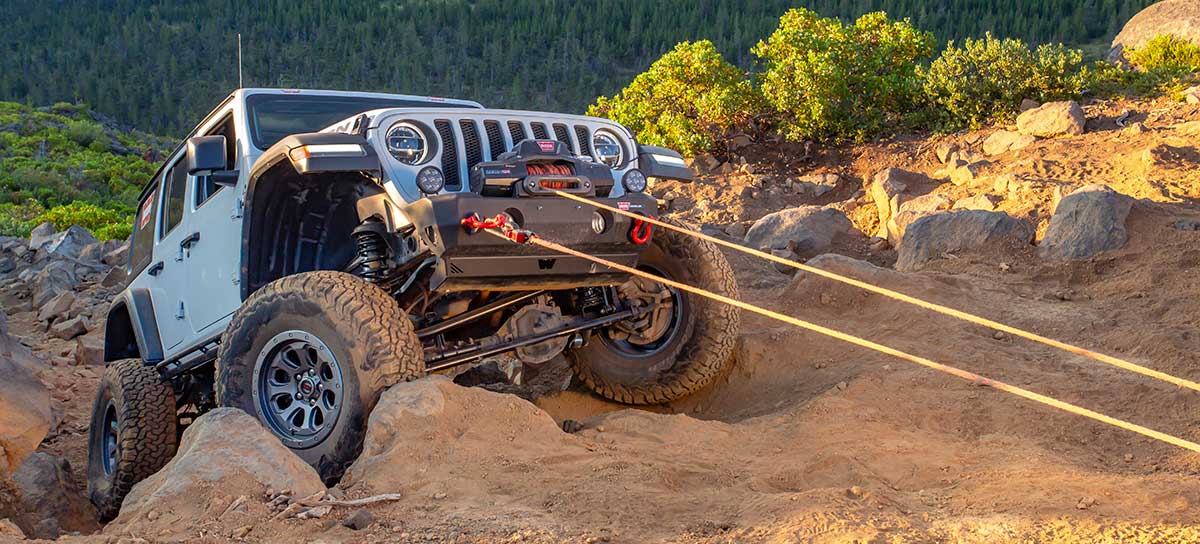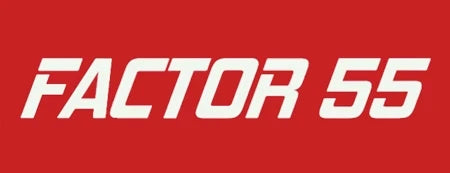

A winch is one of the most versatile tools out there for getting your rig unstuck, and there are techniques you can use to make your winch even more effective and powerful. One important recovery method is the double-line pull. It will effectively double your winch’s pulling ability through mechanical advantage. Once you learn how it works, it can be an invaluable.

Understanding a Winch’s Capacity
Before explaining this further, it’s important to understand how to achieve your winch’s maximum pulling capacity. This occurs when there’s just one wrap of rope around the drum. (You lose about 10% capacity for every layer of rope on top of that.) So, if you have 100 feet of rope on your winch drum and it’s rated at 10,000 lbs., you’ll need to pull most of line off to get to that maximum pulling potential. If you just pull 10 feet of rope off your drum, you’re nowhere near its maximum 10,000 lb. pulling capacity. Employing the double-line pull can help get more rope off your drum and get you closer to that maximum capacity. We’ll explain more shortly.

What is a Double-Line Pull?
To understand what a double-line pull is, we need to first define a single-line pull. This is the most basic winch pull. It’s when you have your winch’s rope pulled out and anchored to an object. But sometimes, if you or another vehicle is really stuck or you don’t have a lot of room to pull out long lengths of line, a single-line pull won’t cut it.
A double-line pull is when your winch line goes to an anchor point with a pulley (aka snatch block) attached to it, and then the line doubles back to your vehicle as a final anchor. Through mechanical advantage, a double-line pull will allow you to pull nearly twice the winch’s rating under the right conditions.
Since you’re going to an anchor point and doubling back, you’re using twice the amount of line (again, first to the anchor, and then back to your vehicle). Double-line pulls also halve the winch’s line speed because of the pulley.
In short, a double-line pull will provide up to twice the pulling power, but uses twice the amount of line, and moves at half the line speed.
When Should I Perform a Double-Line Pull?
A double-line pull becomes advantageous in multiple instances. Of course, when you don’t have enough power with a single-line pull, a double-line recovery is a great option. And why wouldn’t a single-line pull be enough?
As previously mentioned, a winch’s maximum pulling capacity is when there’s one wrap of rope left on the winch’s drum. Because you lose around 10% of the winch’s pulling capacity for every layer of rope wrapped around a drum, getting as much rope off the drum is what you want for maximum pulling power. Note: If your winch has steel rope, always leave at least half a wrap of rope on the drum. For synthetic rope, leave one full wrap. Since double-line pulls require more rope to be used, you’re also getting additional line off the drum, getting closer to that maximum pulling power with this technique. Again, this is about mechanical advantage and physics.
Double-line pulls are also useful when you don’t have a lot of space to work with. If you are in a tight trail spot in which you could only pull about 20-feet of line out, using a double-line pull would allow you to pull 40-feet of line out, which gets more rope off the drum. But of course, the real magic (okay, less magic and more physics) happens when you use the snatch block.

Shown above: 1.) Factor 55 rigging strap (Tree Saver), 2.) Rope Retention Pulley (RRP) with soft shackle, 3.) Crosby screw pin hard shackle, 4.) 3/4” Standard Soft Shackle
What Equipment Do I Need to Do a Double-Line Pull?
To do a double-line pull, you’ll need a winch and a few appropriately rated accessories. This includes:
• A winch
• Snatch block (aka pulley block)
• If self-recovering, a tree-saver strap to rig the snatch block to an anchor
• A shackle to rig the snatch block to the tree strap
• An appropriate anchor point on the front of the vehicle with another shackle to attach the end of the winch line
The Factor 55 RRP is a lightweight, easy-to-use snatch block solution for use with synthetic rope. If you have steel rope, a traditional swing-plate snatch block, such as a WARN Epic Snatch block is ideal. Always make sure your rigging is appropriately sized and rated for your pulling scenario. Depending on the situation, soft or hard shackles can be used, and you’ll need a static strap, such as a tree saver, to go around a suitable anchor point if self recovering.

Shown above: Factor 55 RRP pulley/snatch block to the tree trunk protector using a soft shackle
How To Rig a Double-Line Pull
In this scenario, we’ll assume you’re doing a self-recovery using a double-line pull.
First, find an anchor point to attach a tree strap. This can be a large tree, boulder, or stump, (another vehicle can be used, but you likely can skip the strap). The anchor must be durable enough to handle the weight of multiple tons of force and placed low on the object.
Next, connect your pulley/snatch block to the tree trunk protector using a shackle, checking to ensure all rigging is done properly.


Next, place your winch in free spool, and pull the line out to the anchor, feeding the rope around the pulley wheel, then walk the line back to the vehicle. Ensure you have a proper recovery point and use an appropriate shackle to attach the end of the line. You’ll want to place a winch line damper on each of the two lines as well.
Remember, if you have a 10,000 lb.-capacity winch, you’ll have up to 10,000 lbs. on the line going to the pulley, 10,000 lbs. on the line going from the pulley to the front of the rig. In this case, the vehicle’s bumper will have as much as 20,000 lbs. of force imparted on it. Make sure your bumper can handle this force. Some winch bumpers, such as those from Warn Industries, are pull tested to twice the maximum winch capacity so you’ll know they can handle this stress.
Finally, it’s Warn’s recommendation to always wear gloves when touching winch line, whether that’s steel or synthetic rope.

Slow, Steady, Powerful
Once you have everything rigged up, you’ve double-checked that your rigging is secure, and people are safely out of the way, you can engage the winch’s clutch and begin your double-line pull. Again, the winch will pull at half the speed of a single-line pull.
A double-line pull is a slow, steady, and powerful way to get your vehicle unstuck. Some people even skip single-line pulls altogether and just go straight for double-lining it every time. This is because the winch doesn’t have to work as hard and the process is slower and more controlled. Yes, it will take more time to set up, but for some it’s worth it. Regardless, always follow winch safety guidelines, take your time, and remember safety should always be your number one priority.
The double-line pull technique is exceptionally useful whether you’ve got a truck, SUV, or powersports vehicle. Be sure to practice the technique in a controlled environment before you need to do it on the trail. Once you’ve practiced this, you’ll have the expertise needed to successfully execute this and keep going on your adventures.
